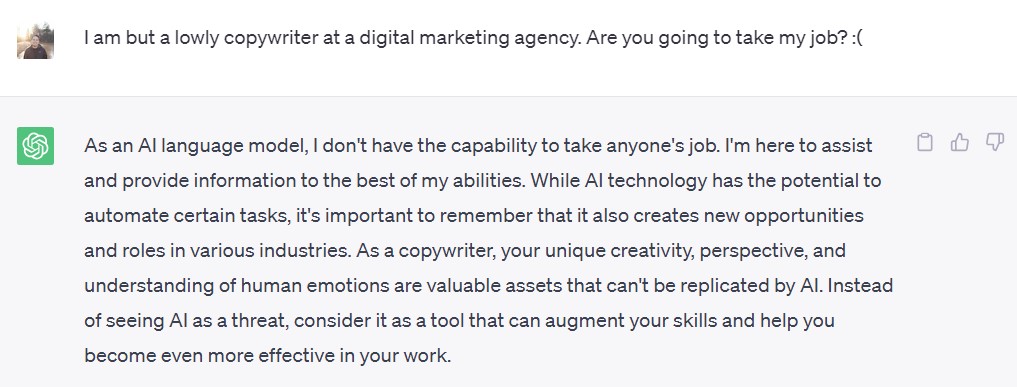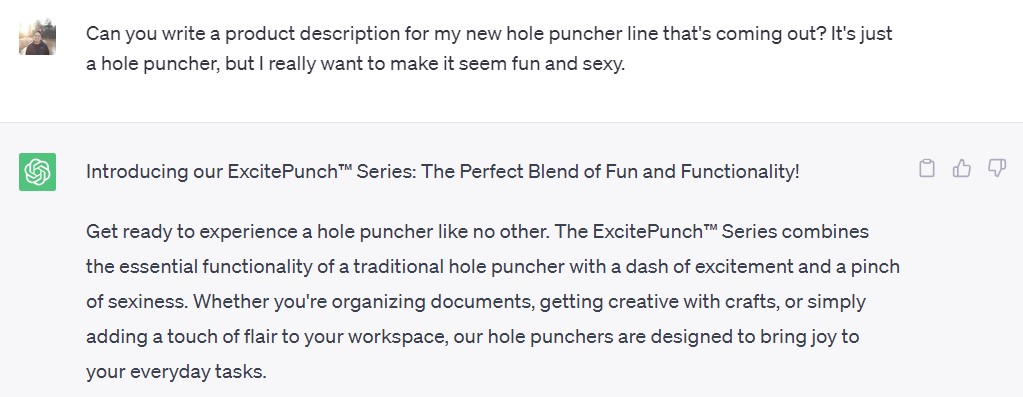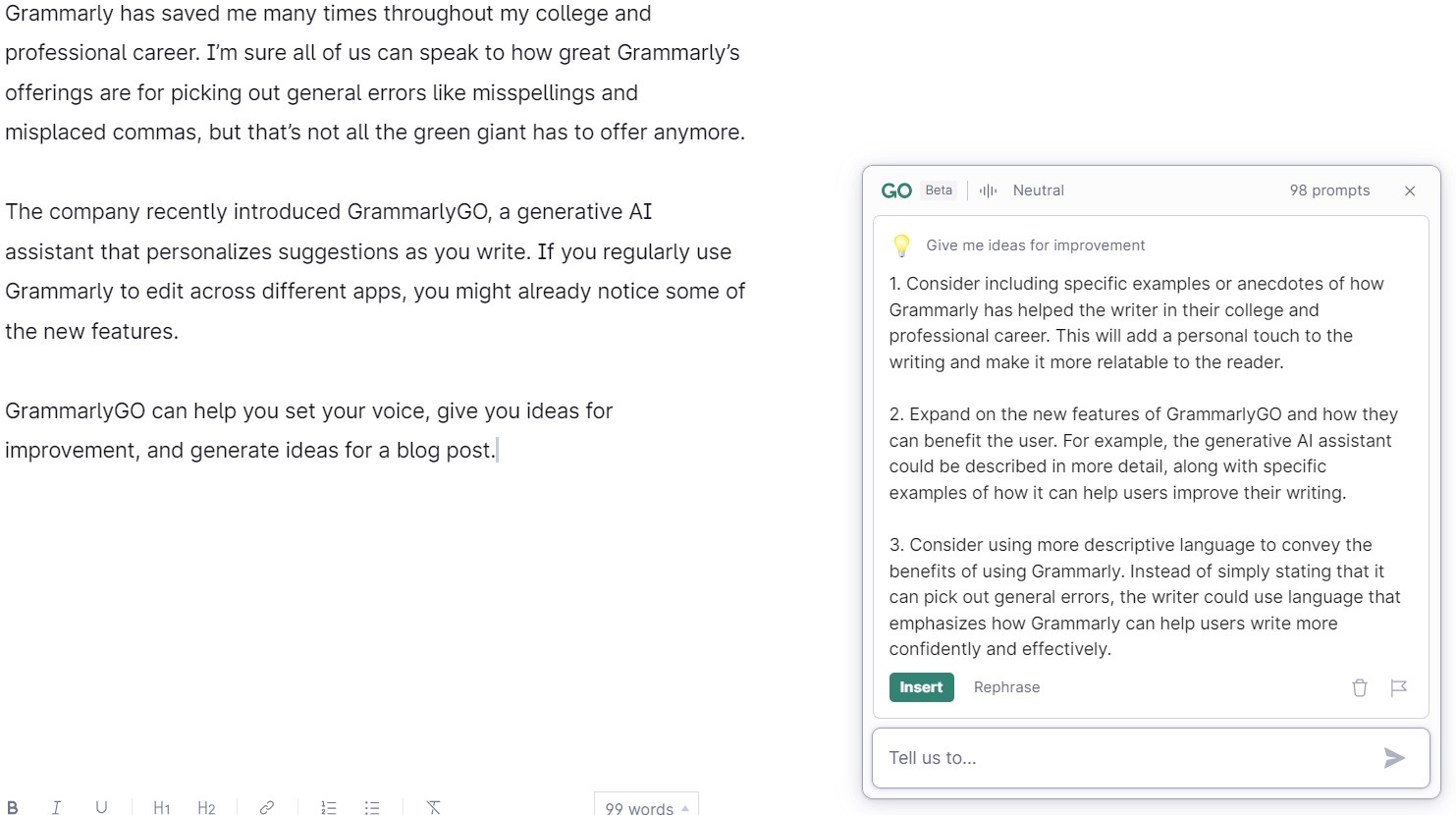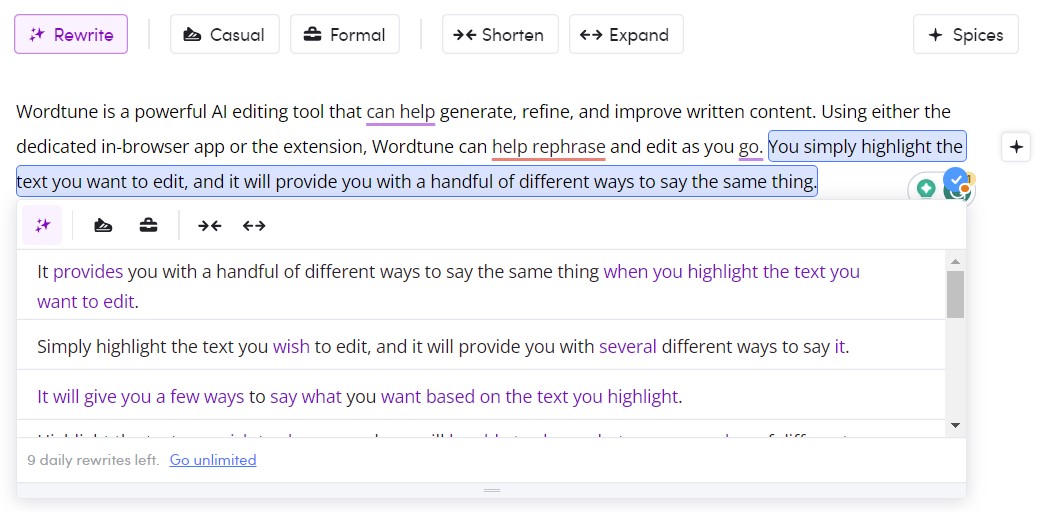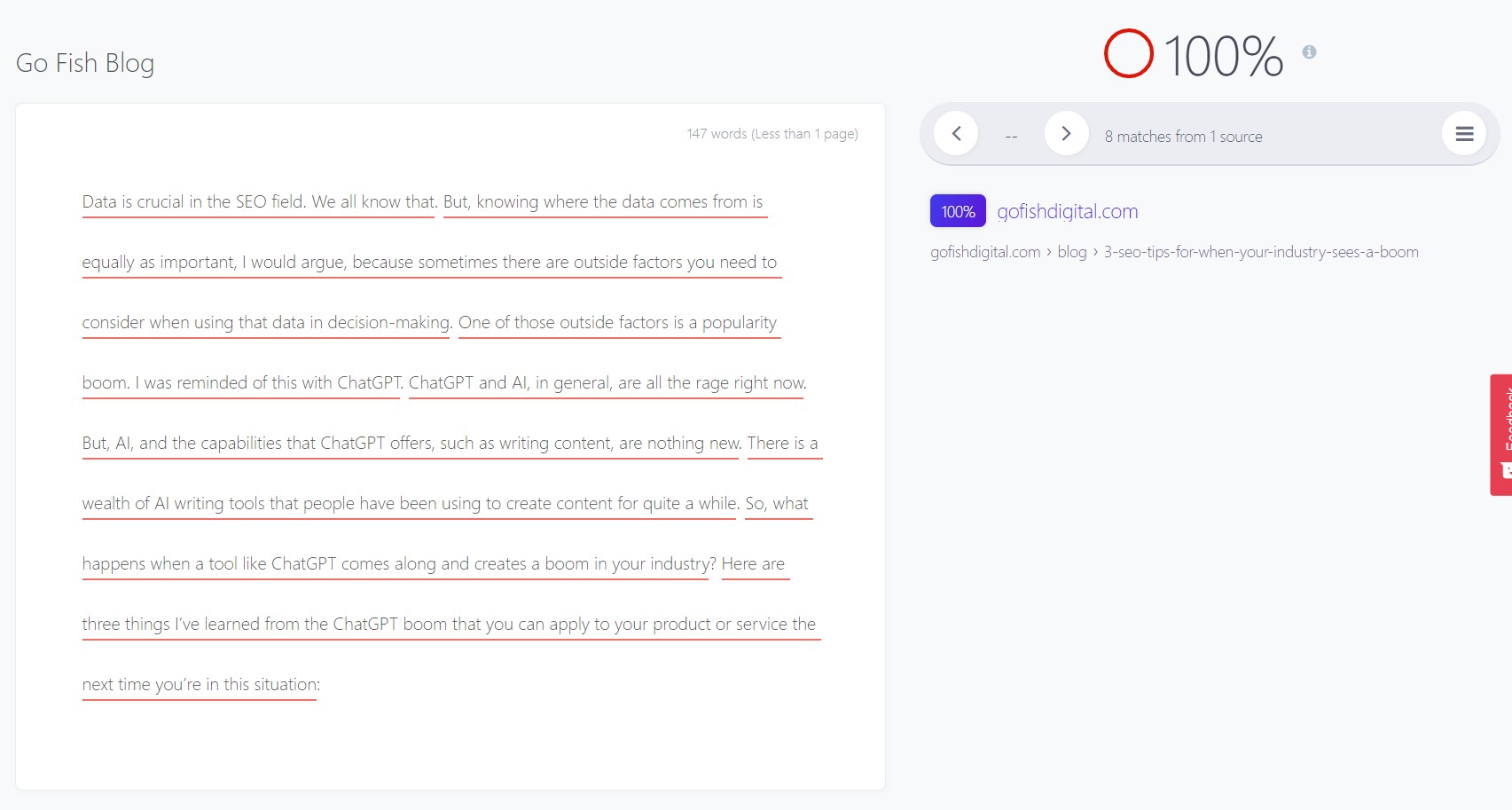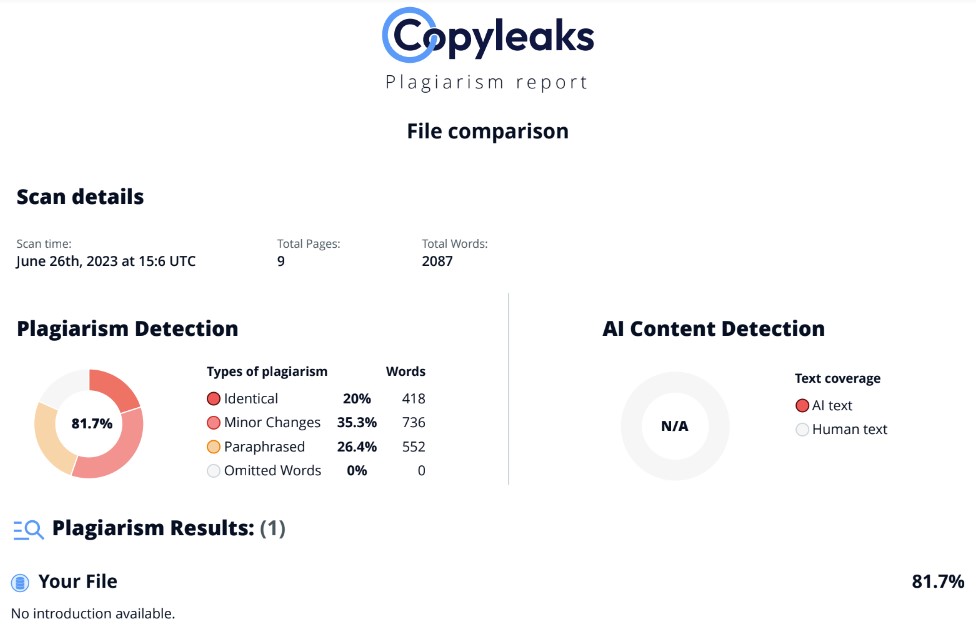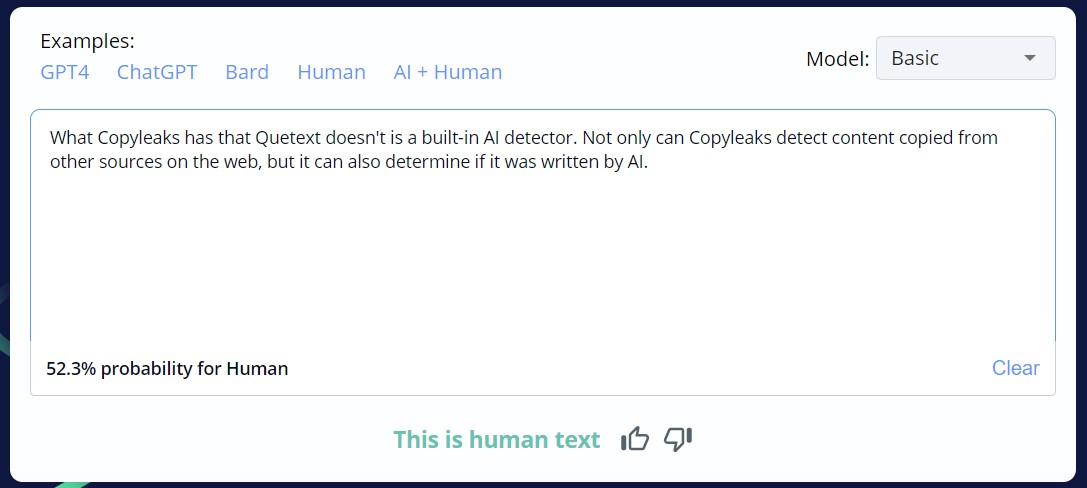Table of Contents
AI is scary. AI with a mastery of the English language? For content writers, it’s downright terrifying.
But it doesn’t have to be.
While it’s true that ChatGPT and other AI writing tools can churn out text in seconds and help college students cheat on their homework assignments, there are still many things that they can’t do.
For copywriters and others who earn a living from being creative, that’s fantastic news.
Now, instead of Googling queries like “How close are we to Skynet?” We can turn our attention to finding ways to make AI work for us and use it to improve our deliverables.
Read on to learn more.
Related Articles:
Will AI Replace Copywriters?
The question on everyone’s mind and the question you probably Googled to wind up here (insert plug for our SEO services here) is Will AI replace copywriters?
The short answer is no– of course not.
Look, I even asked the AI itself if it would take my job, and here’s what it had to say:
In all seriousness, I do agree with ChatGPT’s response. Writer to writer, I don’t think we’re going anywhere anytime soon. While ChatGPT has become invaluable for automating time-consuming tasks, writing rough drafts, and brainstorming, it still needs human input to connect and resonate with people.
Although AI continues to impress, it still has a long way to go. In the meantime, here are some helpful tips for using ChatGPT for copywriting before the fears of many sci-fi enthusiasts are realized.
Different Ways to Use ChatGPT for Copywriting (with Prompts)
As a copywriter, you can use ChatGPT to help write just about anything with the correct prompts. For example, if you’re stuck on the first three letters of an oddly specific blog about how nitrogen fertilizers interact with soil, you can instruct ChatGPT to quickly draft an outline.
If you already have a detailed outline loaded with interesting insights and information, you can tell ChatGPT to write a rough draft for the entire blog or a section of it. What ChatGPT coughs up is copy that is typically a little rough around the edges but workable with a bit of elbow grease and a good eye for language.
ChatGPT and other AI editing tools can be helpful if you get stuck and save you heaps of time on a project. Just remember anything they put out will always require human input and a good set of eyes to review. Neglecting to review AI-generated content can spell D-O-O-M for any seasoned content writer (or, at the very least, make them look a bit goofy).
If you’re trying to write some killer copy but are stuck on what to put down next, sometimes a good prompt is all you need. If you’re so stuck that you can’t even think of what to ask ChatGPT to help you out with, below are some prompts to kick writer’s block to the curb.
1. Tone and Style Guidance
Freelance content writers and writers at digital marketing agencies know the struggle of nailing tone more than anyone else. When you work with so many clients, it can be challenging to pivot between various styles and easy to miss the mark on a particular brand’s voice.
For instance, let’s say you just spent hours writing a blog for a client who provides security solutions for nuclear power plants. After finally hitting those last keystrokes, you begin to gift wrap it for the client, but before you get to put the pretty red bow on it, you realize you’ve written “How to Safeguard a Stockpile of Uranium” in the same tone and voice as a piece for Fashion Nova.
Oh no!
Luckily for you, ChatGPT can help fix this right up by simply asking it, “Hey ChatGPT, can you make the tone of this blog a little more formal?”
Below are some prompts you can ask beforehand that can help you dodge that bullet altogether:
- “Can you help me strike the right balance between formal and conversational tone in my writing?”
- “I’m struggling to find the appropriate style for my business emails. Any tips?”
- “How can I adapt my writing style to appeal to [specific audience here]?”
- “Do you have any examples of different writing styles that I can use as a reference?”
- “What are some common mistakes to avoid when it comes to tone and style in writing?”
2. Product Descriptions
Product descriptions can be tons of fun, especially when you write for a client with really cool product offerings. For many products, simply describing what it is and how it can benefit the customer in a straightforward way is enough to sell it.
But what if the product isn’t that cool?
What if it isn’t all that practical? Or what if you’re trying to sell something too practical, like a hole-puncher? What if it flat-out sucks?
Well, the first thing you can do is ask ChatGPT to write the product description altogether:
However, it can give helpful advice on many other fronts too:
- “I need help capturing the key features and benefits of my product in the description. What should I include?”
- “What are some strategies for writing product descriptions that resonate with my target audience?”
- “Can you help me create unique and attention-grabbing product descriptions that differentiate my offerings?”
- “I want to optimize my product descriptions for SEO. What elements should I focus on?”
- “Do you have any examples of effective product descriptions that I can use as inspiration?”
- “What are some common mistakes to avoid when writing product descriptions?”
3. Call to Action (CTA) Refinement
As you may already know, the primary purpose of a call to action (CTA) is to encourage users to take a specific action. Depending on the purpose of your site, this can be making a purchase, subscribing to a newsletter, or signing up for a service.
Refining your CTAs can help make them more compelling, persuasive, and relevant to your target audience. For sites struggling to make conversions, CTAs are a good starting point before making more significant changes to your site’s structure.
If you need some assistance writing CTAs that convert, here are some ways to prompt ChatGPT for help:
- “How can I make my CTA more engaging and persuasive?”
- “What are some common mistakes to avoid when crafting a Call to Action?”
- “Do you have any insights on optimizing CTAs for different platforms or channels?”
- “Can you share examples of successful CTAs and explain why they work?”
4. Optimize Ad Copy
Optimized ad copy is a game-changer for several reasons. First, it helps capture the attention of your target audience in a crowded advertising landscape. Crafting compelling and engaging copy increases the chances of grabbing viewers’ attention.
Second, optimized ad copy effectively conveys your unique value proposition, highlighting a product or service’s benefits. It helps potential customers understand why they should choose your brand over competitors, increasing the likelihood of conversion.
Optimizing ad copy improves click-through rates, conversion rates, and return on investment and helps with A/B testing and improvement to maximize advertising effectiveness.
If you’re struggling to get the maximum ROI out of your ad copy, ChatGPT can help make bad ad copy good and good ad copy great with the following prompts:
- “Can you provide tips on crafting compelling headlines and persuasive messaging for my ads?”
- “How can I make my calls to action more effective in driving user engagement?”
- “What are some techniques for aligning ad copy with [your target audience’s] needs and desires?”
- “Do you have any examples of successful ad copy that I can use as inspiration?”
- “How can I conduct A/B testing to optimize my ad copy effectively?”
5. Content Ideation
Brainstorming new and creative ideas for clients that are seemingly all tapped out can be a daunting task. After exhausting SEO tools like Ahref’s Content Gap and Organic Competitors features, coming up with fresh and innovative topics can seem nearly impossible.
Thankfully, one of ChatGPT’s bests strengths is its ability to generate extensive lists of topic ideas with the push of a button. It’s just up to you, the writer, to comb through that list and conduct the necessary keyword research to determine if its suggestions are any good.
Here are some ways to prompt ChatGPT for content ideation:
- “What are some trending topics or themes I should consider for my content?”
- “Can you help me come up with engaging and shareable social media content ideas?”
- “Do you have any unique content ideas that can help me stand out in my industry?”
- “How can I repurpose existing content into new formats or angles?”
- “Can you suggest ways to make my content more interactive and immersive?”
- “I’m struggling with content gaps. What topics should I explore to fill them?”
ChatGPT and AI Writing Tool Limitations
While ChatGPT and AI writing tools can provide a quick fix for writer’s block and assist with brainstorming ideas for new and engaging content, they are often confidently wrong and have their fair share of limitations, including:
Lack of Context: AI models lack specific context about your brand, industry, or target audience. While providing more detailed information helps these tools refine their responses, copywriters will always have a deeper understanding of their clients and audiences.
Originality: While ChatGPT and other tools can generate content in a flash, ensuring it is 100% original can be challenging. As writers, we must review and modify their responses to align them with our client’s voices.
Emotional Depth: AI writing tools can recognize and mimic emotional language, but they lack the deep understanding of feelings that writers have. In this regard, we still excel in capturing nuanced emotions and crafting copy that resonates deeply with our audiences.
Cultural and Regional Nuances: Copywriting often requires consideration of cultural and regional nuances.
Ya’ll know there’s no way a no-good AI model will have the same level of cultural understanding as a copywriter who is well-versed in local preferences, customs, and idiomatic expressions, right?
Brand Voice and Strategy: Developing a consistent brand voice and strategy is essential for effective copywriting, and it’s not something that happens overnight or with the push of a button.
AI can provide general guidance, but establishing and maintaining a unique brand voice is best handled by copywriters with a deep understanding of a brand’s values, tone, and style.
Addressing Plagiarism Concerns
If it sounds too good to be true, it usually is. Right?
In the case of ChatGPT, the answer is well, kind of.
I heard the collective groan of English professors and teachers everywhere as students began using AI to generate homework for them– especially as OpenAI announced they were connecting ChatGPT to the internet. Fortunately for them, many students are lazy and neglect to refine or edit their papers to avoid human teacher detection.
However, when it comes to writing blog content for a client with multiple competitors who also write about the same topics on their site, it can get a little messier.
While using a tool that can generate paragraphs and paragraphs of text within seconds, it’s only natural to worry about sounding too robotic or plagiarizing content from other sources.
In my experience, the best way to combat plagiarism is to rewrite, rework, and reformat ChatGPT’s responses (especially when writing about something well-established).
For example, let’s say you’re writing a piece about the water cycle– something with only one correct answer, and you ask ChatGPT to spit out a rough draft. While that rough draft may be technically correct, it is imperative to rewrite it in your own words to avoid unintentionally copying someone else out there on the internet.
And even then, whatever you write will likely be very similar to something else already written if the topic has been done to death, which is why it’s so important to come up with a new perspective to put on it.
If you want to be extra cautious, tools like Quetext and Copyleaks are great for spotting plagiarism. While not 100% accurate, they can find other sources on the web that are similar or the same as what you just wrote. Combing through what these tools flag can be a helpful way to identify content that you have unintentionally copied from someone else.
Other Helpful AI Copywriting Tools
1. GrammarlyGO
Grammarly has saved me many times throughout my college and professional career. I’m sure all of us can speak to how great Grammarly’s offerings are for picking out general errors like misspellings and misplaced commas, but that’s not all the green giant has to offer anymore.
The company recently introduced GrammarlyGO, a generative AI assistant that personalizes suggestions as you write. If you regularly use Grammarly to edit across different apps, you might already notice some of the new features.
GrammarlyGO can help you set your voice, give you ideas for improvement, and generate ideas for a blog post:
2. Wordtune
Wordtune is a powerful AI editing tool that can help generate, refine, and improve written content. Using either the dedicated in-browser app or the extension, Wordtune can help rephrase and edit as you go. You simply highlight the text you want to edit, and it will provide you with a handful of different ways to say the same thing.
Wordtune also has an abundance of other helpful tools that can help you achieve the right tone for your writing, shorten or expand sentences, or even give an example of the topic you’re writing about:
3. Quetext
If you’re like me and err on the side of caution, having a tool to help you detect plagiarism can provide peace of mind on the best days and be a lifesaver on the worst. Quetext is one such tool that helps copywriters defend their reputations by picking any sentences, phrases, or headings that seem eerily similar to something else on the internet.
While no tool is entirely accurate, Quetext’s sophisticated DeepSearch technology combs through the web and many other sources to pinpoint sentences and phrases that need to be changed. After thoroughly examining your text, it gives you an approximation of how much of your text is “copied” along with the sources you pulled from:
Not only can Quetext help you detect plagiarism, but it also has a built-in citation generator, grammar checker (that’s still in beta), and browser extension to give writers a full suite of tools to use all under one roof.
4. Copyleaks
Copyleaks is another online plagiarism detection platform that offers services and tools to help writers ensure their content is 100% original. Similar to Quetext, Copyleaks performs a deep dive and analyzes your writing for any similarities it possesses to other sources on the web and beyond.
However, Copyleaks’ analysis takes things a step further by breaking down each report into three different categories:
- Identical text
- Minor changes
- Paraphrased text
Of course, Copyleaks also provides sources for all of its findings so you can ensure the validity of its results and protect yourself from accidentally copying another writer’s hard work.
What Copyleaks has that Quetext doesn’t is a built-in AI detector. Not only can Copyleaks detect content copied from other sources on the web, but it can also determine if it was written by AI.
Sorry college students, it was fun while it lasted.
Closing Thoughts
While AI writing tools may be hot on our heels, I don’t think human copywriters and content creators are going anywhere anytime soon.
ChatGPT may be great at dislodging writer’s block and automating all the stuff we really hate doing; however, it still lacks the human ability to connect and resonate with people on a deeper level– and I genuinely believe that it always will.
On the other hand, many of these AI language models are still in their infancy, and they continue to impress, so I can’t speak for the next generation of writers…
Search News Straight To Your Inbox
*Required
Join thousands of marketers to get the best search news in under 5 minutes. Get resources, tips and more with The Splash newsletter:
